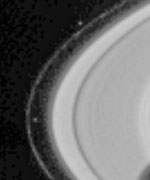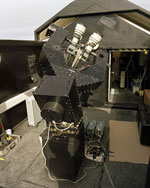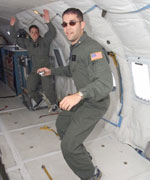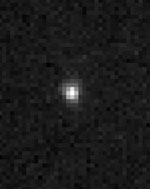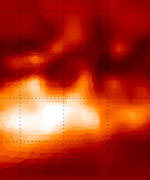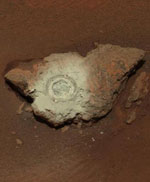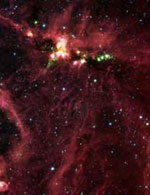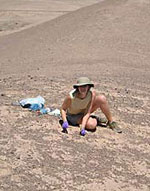
Image credit: UC Berkeley
The same cutting-edge technology that speeded sequencing of the human genome could, by the end of the decade, tell us once and for all whether life ever existed on Mars, according to a University of California, Berkeley, chemist.
Richard Mathies, UC Berkeley professor of chemistry and developer of the first capillary electrophoresis arrays and new energy transfer fluorescent dye labels – both used in today’s DNA sequencers – is at work on an instrument that would use these technologies to probe Mars dust for evidence of life-based amino acids, the building blocks of proteins.
Graduate student Alison Skelley at the Rock Garden, one of the sites in Chile’s Atacama desert where researchers sampled soil for amino acids in preparation for sending an instrument to Mars to look for signs of life. The ruins of the city of Yunguy are in the background. (Photo courtesy Richard Mathies lab/UC Berkeley)
With two development grants from NASA totaling nearly $2.4 million, he and team members from the Jet Propulsion Laboratory (JPL) at the California Institute of Technology and UC San Diego’s Scripps Institution of Oceanography hope to build a Mars Organic Analyzer to fly aboard NASA’s roving, robotic Mars Science Laboratory mission and/or the European Space Agency’s ExoMars mission, both scheduled for launch in 2009. The ExoMars proposal is in collaboration with Pascale Ehrenfreund, associate professor of astrochemistry at the University of Leiden in The Netherlands.
The Mars Organic Analyzer, dubbed MOA, looks not only for the chemical signature of amino acids, but tests for a critical characteristic of life-based amino acids: They’re all left handed. Amino acids can be made by physical processes in space – they’re often found in meteorites – but they’re about equally left- and right-handed. If amino acids on Mars have a preference for left-handed over right-handed amino acids, or vice versa, they could only have come from some life form on the planet, Mathies said.
“We feel that measuring homochirality – a prevalence of one type of handedness over another – would be absolute proof of life,” said Mathies, a UC Berkeley member of the California Institute for Quantitative Biomedical Research (QB3) . “That’s why we focused on this type of experiment. If we go to Mars and find amino acids but don’t measure their chirality, we’re going to feel very foolish. Our instrument can do it.”
The MOA is one of a variety of instruments under development with NASA funding to look for the presence of organic molecules on Mars, with final proposals for the 2009 mission due in mid-July. Mathies and colleagues Jeffrey Bada of Scripps and Frank Grunthaner of JPL, who plan to submit the only proposal that tests for amino acid handedness, have put the analyzer to the test and shown that it works. The details of their proposal are now on the Web at http://astrobiology.berkeley.edu.
In February, Grunthaner and UC Berkeley graduate student Alison Skelley traveled to the Atacama desert of Chile to see if the amino acid detector – called the Mars Organic Detector, or MOD – could find amino acids in the driest region of the planet. The MOD easily succeeded. However, because the second half of the experiment – the “lab-on-a-chip” that tests for amino acid handedness – had not yet been married to the MOD, the researchers brought the samples back to UC Berkeley for that part of the test. Skelley has now successfully finished these experiments demonstrating the compatibility of the lab-on-a-chip system with the MOD.
“If you can’t detect life in the Yungay region of the Atacama Desert, you have no business going to Mars,” Mathies said, referring to the desert region in Chile where the crew stayed and conducted some of their tests.
Mathies, who 12 years ago developed the first capillary array electrophoresis separators marketed by Amersham Biosciences in their fast DNA sequencers, is confident that his group’s improvements to the technology utilized in the genome project will feed perfectly into the Mars exploration projects.
“With the kind of microfluidic technology we’ve developed and our capability to make arrays of in situ analyzers that conduct very simple experiments relatively inexpensively, we don’t need to have people on Mars to perform valuable analyses,” he said. “So far, we’ve shown this system can detect life in a fingerprint, and that we can do a complete analysis in the field. We’re really excited about the future possibilities.”
Bada, a marine chemist, is the exobiologist on the team, having developed nearly a dozen years ago a novel way to test for amino acids, amines (the degradation products of amino acids) and polycyclic aromatic hydrocarbons, organic compounds common in the universe. That experiment, MOD, was selected for a 2003 mission to Mars that was scrapped when the Mars Polar Lander crashed in 1999.
Since then, Bada has teamed with Mathies to develop a more ambitious instrument that combines an improved MOD with the new technology for identifying and testing the chirality of the amino acids detected.
The ultimate goal is to find proof of life on Mars. The Viking landers in the 1970s unsuccessfully tested for organic molecules on Mars, but their sensitivity was so low that they would have failed to detect life even if there were a million bacteria per gram of soil, Bada said. Now that the NASA rovers Spirit and Opportunity have almost certainly shown that standing water once existed on the surface, the aim is to find organic molecules.
Bada’s MOD is designed to heat Martian soil samples and, in the low pressures at the surface, vaporize any organic molecules that may be present. The vapor then condenses onto a cold finger, a trap cooled to Mars’ ambient nighttime temperature, approximately 100 degrees below zero Fahrenheit. The cold finger is coated with fluorescamine dye tracers that bind only to amino acids, so that any fluorescent signal indicates that amino acids or amines are present.
“Right now, we are able to detect one trillionth of a gram of amino acids in a gram of soil, which is a million times better than Viking,” Bada said.
The added capillary electrophoresis system sips the condensed fluid off the cold finger and siphons it to a lab-on-a-chip with built-in pumps and valves that route the fluid past chemicals that help identify the amino acids and check for handedness or chirality.
“MOD is a first stage interrogation where the sample is examined for the presence of any fluorescent species including amino acids,” Skelley said. “Then, the capillary electrophoresis instrument does the second stage analysis, where we actually resolve those different species and can tell what they are. The two instruments are designed to complement and build on one another.”
“Rich has taken this experiment into the next dimension. We really have a system that works,” Bada said. “When I started thinking about tests for chirality and first talked to Rich, we had conceptual ideas, but nothing that was actually functioning. He has taken it to the point where we have an honest-to-God portable instrument.”
Amino acids, the building blocks of proteins, can exist in two mirror-image forms, designated L (levo) for left-handed and D (dextro) for right-handed. All proteins on Earth are composed of amino acids of the L type, allowing a chain of them to fold up nicely into a compact protein.
As Mathies describes it, the test for chirality takes advantage of the fact that left-handed amino acids fit more snugly into a left-handed chemical “mitt” and right-handed amino acids into a right-handed mitt. If both left- and right-handed amino acids travel down a thin capillary tube lined with left-handed mitts, the left-handed ones will travel more slowly because they slip into the mitts along the way. It’s like a left-handed politician working a crowd, he said. She’ll move more slowly the more left-handed people in the crowd, because those are the only people she will shake hands with. In this case, the left-handed mitt is a chemical called cyclodextrin.
Different amino acids – there are 20 different kinds used by humans – also travel down the tube at different rates, which allows partial identification of those present.
“After amino acids are detected by MOD, the labeled amino acid solution is pumped down into microfluidics and crudely separated by charge,” Mathies said. “The mobility of the amino acids tells us something about charge and size and, when cyclodextrins are present, whether we have a racemic mixture, that is, an equal amount of left- and right-handed amino acids. If we do, the amino acids could be non-biological. But if we see a chiral excess, we know the amino acids have to be biological in origin.”
The state-of-the-art chip designed and built by Skelley consists of channels etched by photolithographic techniques and a microfluidic pumping system sandwiched into a four-layer disk four inches in diameter, with the layers connected by drilled channels. The tiny microfabricated valves and pumps are created from two glass layers with a flexible polymer (PDMS or polydimethylsiloxane) membrane in between, moved up and down using a pressure or vacuum source. UC Berkeley physical chemist James Scherer, who designed the capillary electrophoresis instrument, also developed a sensitive fluorescence detector that quickly reads the pattern on the chip.
One of the team’s current NASA grants is for development of a next-generation Microfabricated Organic Laboratory, or MOL, to fly to Mars, Jupiter’s moon Europa or perhaps a comet and conduct even more elaborate chemical tests in search of a more complete set of organic molecules, including nucleic acids, the structural units of DNA. For now, however, the goal is an instrument ready by 2009 to go beyond the current experiments aboard the Mars 2003 rovers and look for amino acids.
“You have to remember, so far we have not detected any organic material on Mars, so that would be a tremendous step forward,” Bada said. “In the hunt for life, there are two requirements: water and organic compounds. With the recent findings of the Mars rovers that suggests that water is present, the remaining unknown is organic compounds. That’s why we are focusing on this.
“The Mars Organic Analyzer is a very powerful experiment, and our great hope is to find not only amino acids, but amino acids that look like they could come from some sort of living entity.”
Original Source: Berkeley News Release
